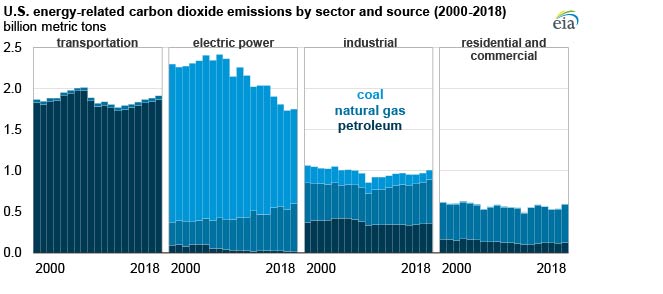
Total U.S. energy-related carbon dioxide (CO2) emissions in 2018 rose to 5.27 billion metric tons, 2.7% more than its 2017 level. The primary reasons for the increase were higher natural gas-related emissions resulting from more extreme summer and winter weather and growth in transportation-related petroleum emissions, linked to a strong economy. U.S. energy-related CO2 emissions declined in 6 of the past 10 years and were 12% lower in 2018 than in 2005, according to a data series published in the U.S. Energy Information Administration’s (EIA) Monthly Energy Review.

Coal-related CO2 emissions declined by 4% in 2018, making coal the only fossil fuel with lower CO2 emissions in 2018 compared with 2017. Total U.S. emissions from natural gas first surpassed emissions from coal in 2015. Natural gas consumption has increasingly displaced coal consumption in the electric power sector in recent years.
Natural gas consumption and emissions increased in 2018 largely because of colder winter and hotter summer weather. Natural gas is both the most prevalent home heating fuel and the most prevalent fuel used to generate electricity. Because both heating and cooling demand were higher in 2018, total natural gas emissions increased by 10%.
U.S. petroleum consumption also increased in 2018, contributing to a 1.9% increase in energy-related CO2 emissions from petroleum. Relatively strong economic growth spurred growth in diesel consumption, which resulted in a 6% increase in related CO2 emissions.

Total U.S. electricity generation increased by 3.6% in 2018, but electric power sector CO2 emissions only increased by 1.1%. In recent years, the U.S. electricity generation mix has shifted away from coal and toward natural gas and renewables. The shift from coal to natural gas lowers the CO2 emissions' intensity because natural gas produces lower emissions per unit of energy used than coal and because natural gas-fired generators typically use less energy than coal plants to generate each kilowatthour of electricity.
Electricity generation from renewable energy technologies has also increased, and most renewables do not directly emit CO2 as part of their electricity generation. In EIA’s emissions data series, emissions from biomass combustion, which do produce energy-related CO2, are excluded from reported energy-related emissions according to international convention.
The increase in residential and commercial sector CO2 emissions was largely caused by weather. Warmer summers increase electricity consumption for cooling, and colder winters increase electricity consumption for heating (as well as heating-related consumption of natural gas and petroleum). Residential CO2 emissions increased 7.4% and commercial sector CO2 emissions increased 2.8%.

From 2005 to 2018, the U.S. economy grew by 25% while U.S. energy consumption grew by 1%. Energy-related CO2 emissions as of 2018 were 12% lower than their 2005 levels. The economic growth that occurred in 2018 was 29% less carbon-intensive than it was in 2005, and the overall energy consumption in the United States was 13% less carbon-intensive.




Follow us on social media: